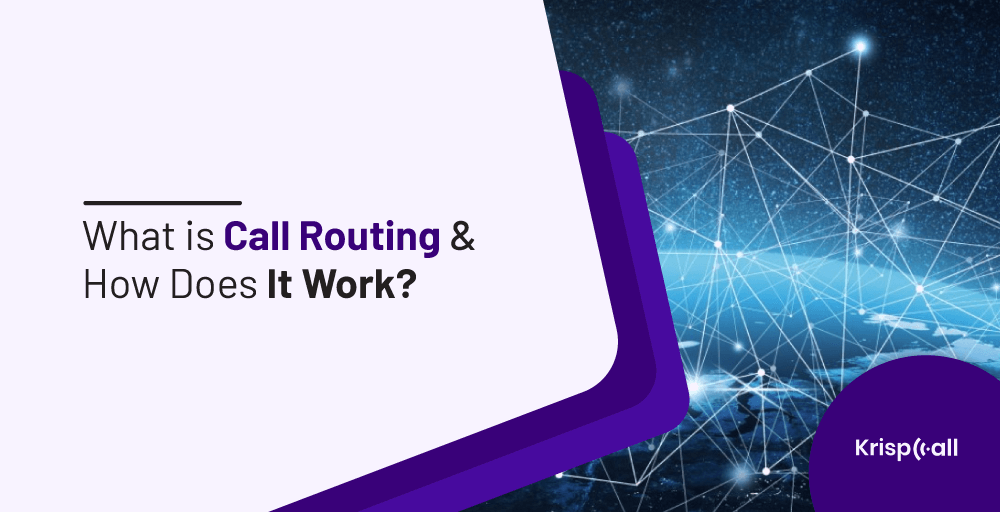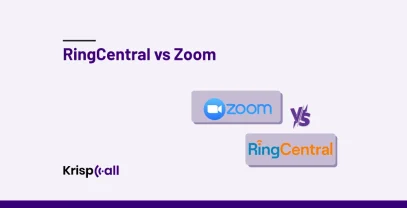It is quite common in call centers to receive a large number of calls simultaneously due to seasonality, software issues, and so forth. To avoid your agents being overburdened when the call volume increases, you need to ensure they’re not overwhelmed.
One of the greatest concerns of a business owner is the prospect of finding themselves at a dead-end, hearing a forgotten voicemail message, or speaking with the wrong person in the organization. It can be extremely helpful to your team to have a seamless call routing process.
Let’s have a closer look at what call routing is and how it works. In addition, you will also learn about:
- How Does Call Routing Work
- Methods of Routing
- Benefits of Call Routing
- Types of Call Routing
Let’s get started.
What is Call Routing?
Call routing is an attribute of modern phone systems that automatically redirects the inbound calls to the right person or agents of departments. It is a call management system feature that uses certain criteria to route incoming calls. During routing, calls are placed, and according to criteria, they are routed to individuals or groups. A few criteria are centered’ capacity, skill-based, or routing to certain departments.
The routing of a call or message must go through a series of interconnected networks to reach its recipient. Call routing optimization helps improve call quality, strengthen connections, and reduce dropped calls. In addition to meeting customer needs quickly, calling routing allows them to have a better overall experience.
Call routing provides a more efficient and personalized customer experience by anticipating demands and automating processes where possible-which positively impacts a company’s bottom line.
How Does Call Routing Work?
Call routing systems basically send incoming calls through a routing engine until they reach their final destination. A call routing system uses various types of information to determine the best place to route calls.
A call routing algorithm matches historic data or other customer demographics with predesigned criteria to route calls to the right team member or message based on the system’s assessment. Generally, the call routing process includes three distinct processes, and they are:
Qualifying Process
The qualification process involves routing callers to an interactive voice response system, which will help them decide what they need and who they need to speak with.
In addition to showing which IVR options in your menu are frequently used, a good call routing platform can even show how well they are performing, very helpful for making improvements to the menu.
Call Queuing
A caller is put in a queue when forwarded to the automatic call distribution (ACD) through a call queuing system. ACD routes call according to factors such as skills, wait times, departments, talk-time distribution, or other settings that you establish at your contact center.
Call Distribution
Calls are distributed according to your rules based on predetermined criteria during the call distribution process. In order to route incoming calls to the right agents, Auto Attendants provide different options to incoming callers.
It also saves your customers and agents time. Because the call will not have to go through an internal operator, customers do not have to wait on hold for their calls to be answered.
Methods of Call Routing
The following are examples of call routing policies used by your contact center:
- Simultaneous: This call routing method is great for speed because it allows every team member to take a call that rings simultaneously.
- Weighted: Providing a proportionate distribution of calls to the agents in call centers with varying skills, the weighted method is ideal for working with individuals with varying talents.
- Uniform: By using this method, every call is directed to the agent who has been available for the longest.
- Regular: Calls are forwarded chronologically within the system. Unless one or both agents are unavailable, Agent 1 gets the first call, Agent 2 gets the second call, and Agent 3 gets the next call.
- Round-Robin: This method occurs every time a call is placed, allowing everyone to hear it evenly.
Types of Call Routing
There are different types of call routing depending on where the call will be forwarded and how the calls will be queued.
1. Based on location and time
There are several ways to route calls. You can connect your caller to the appropriate support agent in their region by using the caller’s time zone and global location. This approach allows businesses to meet the demands of customers globally while maintaining set contact center hours.
2. Based on skills
The call routing system offers the appropriate agent to handle customer calls based on their skill and knowledge. Using an IVR system, a customer might be routed to a customer service department that handles complaints or returns, for instance. Additionally, it may connect a caller with a technology support specialist.
You can reduce hold times and abandonment rates by quickly connecting a caller to the right representative.
3. Based on Caller ID
Based on the customer’s call history, caller ID routing guides the customer to the appropriate party. A system might direct a customer who has called before about a product to a representative who will recall what they told them earlier. A customer can feel very reassured by this since they don’t need to give their details all over again.
4. Interactive Voice Response (IVR)
Interactive Voice Response systems are a common call center fixture. You can use this tool as a self-service tool so that clients can access information without having to speak with a human agent. Customer calls can be directed by IVR systems based on the way the customer expresses their needs.
Benefits of Call Routing
Whether it is for customers or contact centers, call routing offers a wide range of benefits.
1. Provide faster service to customers
The call routing system automatically assigns calls to available agents when they are in place. So customers don’t have to wait in long call queues. The application enables customers to reach the right person when they call in.
2. Ensure customer satisfaction
Call routing helps to minimize the communication gap between businesses and their customers. It makes businesses more reachable and customers can get support and assistant in a minimum time. So customers don’t have to wait in queue or remain on hold for minutes to get support and answer their queries.
When customers’ calls get answered right away, it helps to improve their experience with the business. So call routing also helps to ascertain customer satisfaction. And you don’t have to worry much about losing your clients and customers.
3. Increase agent productivity
Call routing automation could allow your agents to focus on specific expertise, spread calls more evenly among them, among other benefits. The software optimizes your workflow and helps to make the most out of agents’ expertise and creative abilities. This ultimately enhances employee productivity and workspace efficiency. Also, there will be fewer calls on hold and on the queue.
4. Multilingual and multi-time zone scheduling
The benefit of call routing is that you can communicate with local teammates across time zones and countries. It is particularly helpful in our increasingly globalized society to route calls according to various time zones and language preferences.
With multi-time scheduling, companies can make themselves available to their customers 24/7. Using companies’ global networks, it’s possible to route the customer calls to different locations based on the time zones. So there will always be an agent available to take calls, whether it’s the middle of the night or the middle of the day, no matter where your caller is.
Similarly, with multi-lingual scheduling, it’s possible to route the customer calls based on the language they speak. This way, customers can express themselves in their mother tongue or the language they are most comfortable with. It helps to create a strong customer-business relationship and also inspires customer loyalty.
5. Create brand image
A customer support system plays a big role in creating a brand image and building customer trust. No matter how great the products or services a company has to offer if the customer support system is not good enough, customers can back out in time. By providing good customer service, you can lure customers to your business.
Wrapping up
Call routing is an invaluable tool to every company regardless of the size and industry. A call-routing system can improve workforce management, human resources management, and customer experience. A call routing system can facilitate the resolution of customer issues more swiftly, strengthen the relationship between agents and customers, and de-stress your staff.
To optimize the workflow and improve customer satisfaction, call routing is indeed a handy feature. So if you are willing to be more reachable to the customers and strengthen the bond with them, you should definitely consider implementing a call routing system in your office workspace.
With so many call routing software available, choosing one for your business can be a daunting task. But with KrispCall now in the market, you don’t have to go through a cumbersome process of shortlisting such apps and performing rigorous comparisons between them.
KrispCall provides reliable call routing services at the most affordable price. With intelligent and profound routing features like skill-based routing and IVR, KrispCall simplifies complex and demanding call handling tasks.
Using KrispCall’s call routing features, you can save employee and customers’ time for happier teams and clients. No matter how busy the time is, KrispCall will not let a call drop but will place it on hold and transfer it seamlessly.
FAQ
What are the different types of Call Center Routing Strategies?
The different types of call center routing strategies are:
- Direct Routing
- Least Idle Routing
- Skill-Based Routing
- Dynamic Routing
- Cascading Calls Strategy
- Smart Routing Technique
- Value-Based Routing





